JR East Shinkansen
R East operates Shikansen lines to the north and north-west of Tōkyō. The Tōkaidō Shinkansen to the west is operated by JR Central. In addition to lines constructed to full Shinkansen specifications, there are also two lines converted to standard gauge from pre-existing narrow-gauge lines, which are known as Mini-Shinkansen lines. These have more restrictive clearances, prohibiting the use of ordinary Shinkansen trains, but mini-Shinkansen trains can (and do) operate over ordinary Shinkansen lines.
Numerous types of Shinkansen trains are used on these lines, including the venerable 200 series dating from 1980 (and refurbished c. 2000). However, most of these are designs specific to JR East.
Japan’s Shinkansen lines have an enviable safety record: since the start of service in 1964, no passenger has been killed, and few have been injured. A 200-series train derailed at 200 kph during an earthquake in 2004, but no passengers were injured.
200 Series
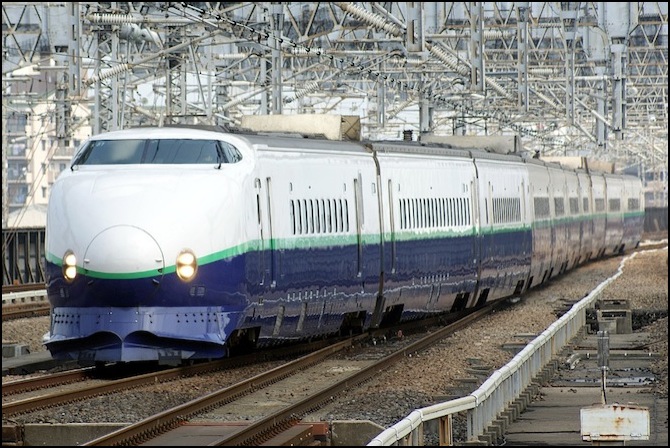
JR East 200 Series Shinkansen in “renewal” colors (2007)
Photographer: Sui-setz
Specifications:
Type: 200 Series (“K sets”)
Size: 8 and 10-car trains
Introduced: 1980, retired from the Tōhoku Shinkansen in 2011 but still used on Jōetsu
Lines: Tōhoku and Jōetsu
Top Speed: 240 kph presently (previously 275 kph)
Power:
Source: 25 kV AC, 50 Hz catenary
The 200 series was refurbished in 1999-2000 for use with the 400-series Yamagata Shinkansen and E3 Akita Shinkansen. These other sets run coupled to the 200-series train from Tōkyō to where their lines branch off, so typical trains in the Tōkyō area are formed of a 200-series set and one of the other sets.
400 Series
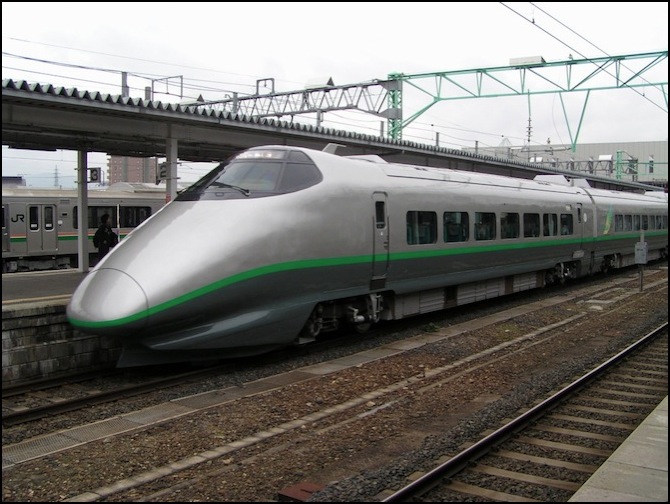
JR East 400 Series Shinkansen (2005)
Photographer: Kouchiumi
Specifications:
Type: 400 Series
Size: 7-car trains
Introduced: 1992, retired in 2010
Lines: Tōhoku and Yamagata
Top Speed: 240 kph, 130 kph on Yamagata line
Power: 5.04 MW (24 x 210 kW), 6,759 hp
Source: 20/25 kV AC, 50 Hz catenary
The 400 series is a Mini-Shinkansen design, built for use on the Yamagata line. Cars were numbered 11 to 17, to avoid conflict with the numbering of the 200-series cars with which it operated. It was replaced by the E3-2000 series, with the last run in 2010.
E1 Series
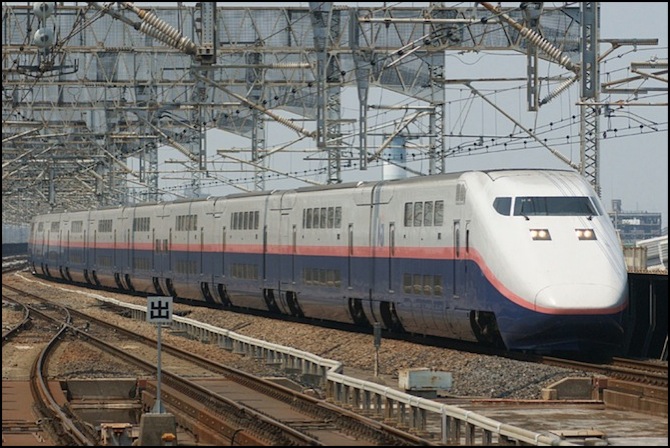
JR East E1 Series Shinkansen (2008)
Photographer: Sui-setz
Specifications:
Type: E1
Size: 12-car trains
Introduced: 1994, retired in 2012
Lines: Jōetsu (and formerly on the Tōhoku)
Top Speed: 240 kph
Power: 9.84 MW (13,196 hp)
Source: 25 kV AC, 50 Hz catenary
The E1 is a double-decker Shinkansen, marketed under the name “Max” (which is also applied to the E4), seating 1,235 passengers.
E2 Series
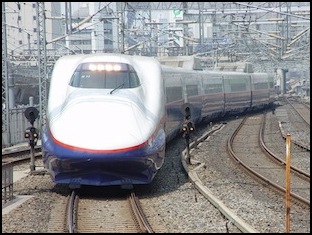
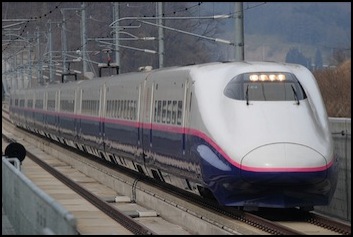
L: JR East E2 Series N11 Shinkansen (2002), R: JR East E2-1000 Series J64 Shinkansen (2007)
Photographers: D A J Fossett, View751
Specifications:
Type: E2 (N series), E2’ (J series), E2-1000 (J50 series)
Size: N series 8-car; J/J50 Series 10-car
Introduced: N/J series 1997; J50 series 2000
Lines: N series Nagano line; J series Tōhoku
Top Speed: 275 kph (on Tōhoku), 265 kph (Nagano)
Power: 8-car set: 24x 300 kW (9,655 hp), 10-car set: 32x 300 kW (12,874 hp)
Source: 25 kV AC, 50 Hz catenary (N and J can also use 50 Hz)
There are three versions of the E2 series: The N series is for use on the Nagano Shinkansen line, using 8-car trains, and is not equipped with a coupler for connecting to a Mini-Shinkansen set (as those are not used on this line). The J and J50 series are for use on the Tōhoku line in 10-car sets (the J series, but not the J50, were used on the Nagano line before being extended to 10-car sets), and are equipped to couple to an E3 Mini-Shinkansen. There are also some superficial differences between the N and J series (left photo above) and the J50 (E2-1000) series (right photo above). Additionally, the N and J series are equipped to also use 60 Hz power, as used on part of the Nagano line, while the J50 series can only use 50 Hz, as this is used exclusively on the Tōhoku line. The E2 is the first JR East Shinkansen with a “duck bill” nose, which reduces noise from the shockwave of a train exiting a narrow tunnel at very high speed.
E3 Series
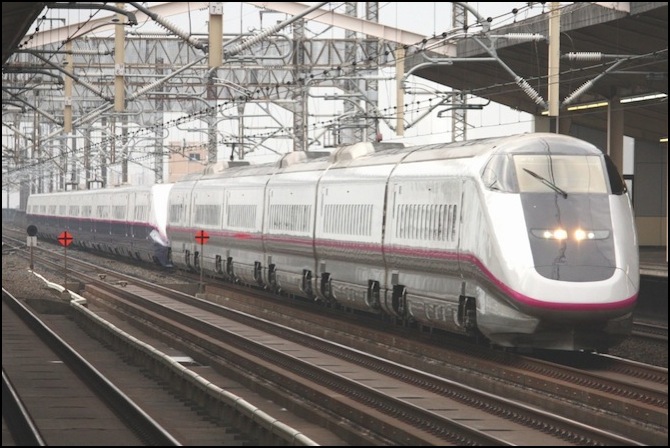
JR East E3 Series Akita Shinkansen coupled to an E2 (2009)
Source: Wikimedia, Photographer: TC411-507
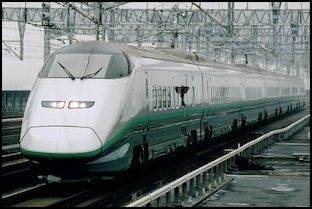
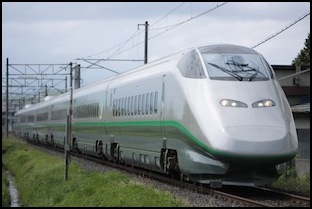
L: JR East E3-1000 Series Yamagata Shinkansen (2003), R: JR East E3-2000 Series Yamagata Shinkansen (2007)
Photographers: Sui-setz, Jet-O
(right image link no longer works)
Specifications:
Type: E3 Mini-Shinkansen
Size: 6- and 7-car train sets
Introduced: 1997
Lines: Tōhoku, Akita and Yamagata
Top Speed: 275 kph (Tōhoku) and 130 kph on the Akita and Yamagata lines
Power: 6-car sets:16x 300 kW (6,437 hp), 7-car sets: 20x 300 kW (8,046 hp)
Source: 20/25 kV AC, 50 Hz catenary
There are three versions of the E3 Mini-Shinkansen: The original Akita Shinkansen sets (built as 5-car sets, later expanded to 6-cars), and the E3-1000 and E3-2000 used on the Yamagata Shinkansen. Both run through onto the Tōhoku Shinkansen, where they couple to E2 series train sets heading towards Tōkyō. The E3-1000 were used alongside the 400 series, but the new E3-2000 replaced the 400 series. This was originally planned by mid-2009, but the last 400 series set actually ran in 2010.
E4 Series
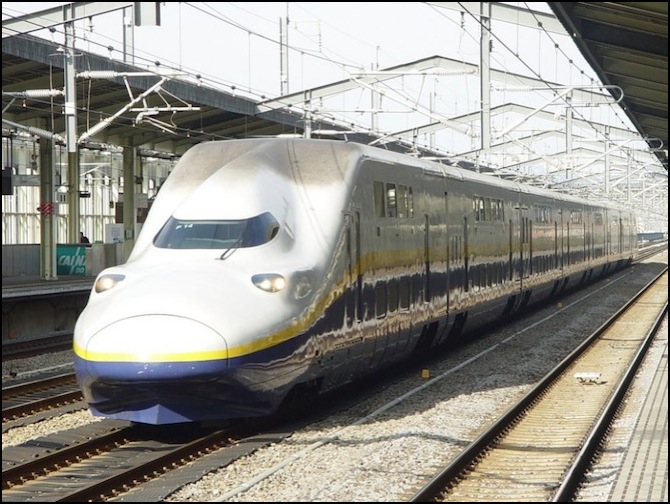
JR East E4 Series Shinkansen (2006)
Source: Wikimedia, Photographer: D A J Fossett
Specifications:
Type: E4
Size: 8-car train sets
Introduced: 1997, due to be retired in 2016
Lines: Tōhoku, Jōetsu and Nagano
Top Speed: 240 kph
Power: 16x 420 kW (9,012 hp)
Source: 25 kV AC, 50 Hz catenary
There E4 is another double-decker (like the E1) design. It is sometimes operated in conjunction with the 400 series Mini-Shinkansen on the Tōhoku line. At present it is the most recent design (not counting variations of older models) used by JR East, but the E5 is expected in 2011.
E5 Series
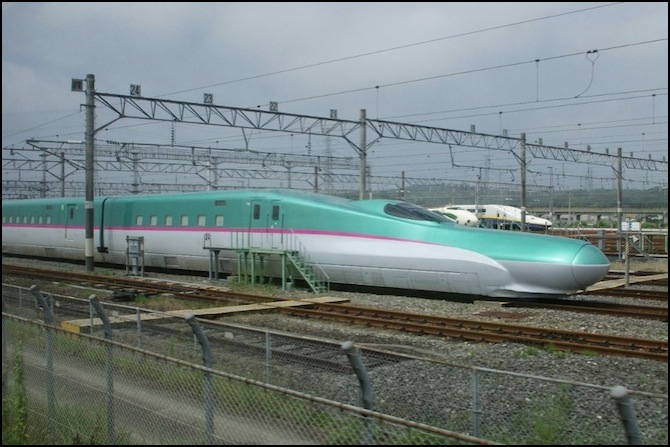
JR East E5 Series (prototype) Shinkansen (2009)
Photographer: D A J Fossett
Specifications:
Type: E5
Size: 10-car train sets
Introduced: 2011 (prototype in testing from 2009)
Lines: Tōhoku
Top Speed: 320 kph (199 mph)
Power: 9,960 kW (13,357 hp)
Source: 25 kV AC, 50 Hz catenary
There E5 series was JR East’s fastest train when introduced, although initially limited to 300 kph operation (320 kph operation is expected in 2014).
E6 Series
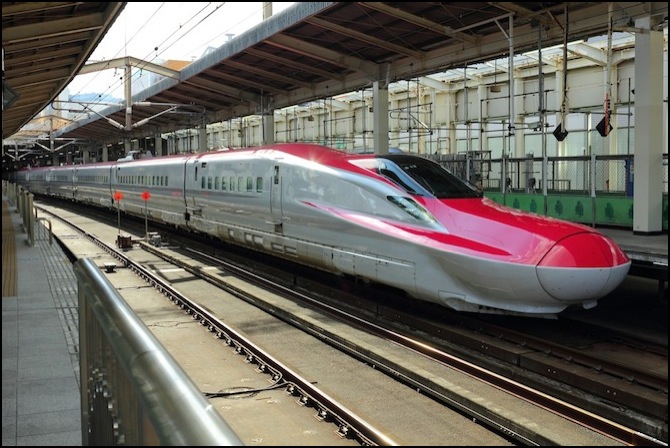
E6 Shinkansen at Sendai Station (2011)
Photographer: Sukhoi37
Specifications:
Type: E6 Mini-Shinkansen
Size: 7-car train sets
Introduced: expected in 2013
Lines: Tōhoku and Akita
Top Speed: 320 kph (Tōhoku) and 130 kph on the Akita
Power: unknown
Source: 20/25 kV AC, 50 Hz catenary
There E6 series is a mini-Shinkansen design to go along with the new E5, and will gradually replace the original model E3 used on the Akita line.
E7/W7 Series
No photo yet. See Wikipedia for an artist’s impression taken from the press release.
Specifications:
Type: E7 and W7 Shinkansen
Size: 12-car train sets (10M2T), used in tandem with 8-car E2
Introduced: expected in late 2013
Lines: Nagano, Tōhoku, Jōetsu, and Hokuriku
Top Speed: 260 kph
Power: unknown
Source: 25 kV AC, 50/60 Hz catenary
The E7 was developed for use on the Hokuriku Shinkansen line along Japan’s west coast, bridging the regions controlled by JR East and JR West. The trains can (will?) operate into Tokyo via the Jōetsu and Tōhoku Shinkansen lines (the existing Nagano Shinkansen line will be incorporated into the Hokuriku line). The train will also be used by JR West, where it will be known as the W7. The E7 has less of a duck-bill aspect than other recent Shinkansen, perhaps due to its lower operating speed. In the 12-car set, 10 cars are motorized. A total of 27 trainsets are planned, 17 E7 and 10 W7.
Note: the “duck bill” design is intended to reduce “tunnel boom”, the sonic-boom like crack occurring when a train exits a very narrow tunnel at high speed pushing a column of air ahead of it.




